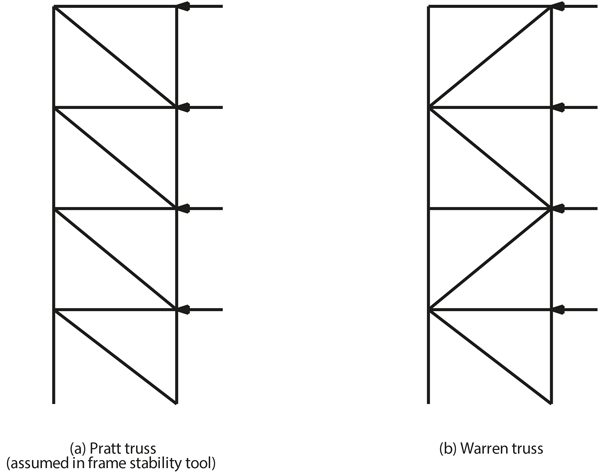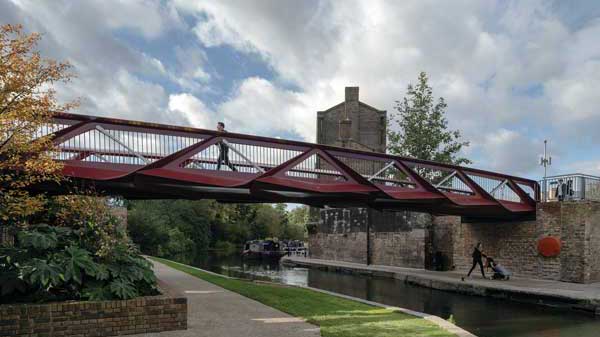Technical
Connection design in trusses
A general article about steel trusses which touched on choice of members and their orientation but did not go into detail about designing connections was published in 2017¹. In the present article Richard Henderson of the SCI illustrates the implications of such choices on the connection design.
Introduction
The selection of members and their orientation and the impact on the design of connections in a truss is best illustrated with an example. The arrangement of the truss, the magnitude of the forces and the orientation of the members all have an impact on the form of the connections. A fundamental part of achieving an efficient joint design is establishing an understanding of the flow of forces through the joint. This is only possible if the forces provided for the design of the joint are in equilibrium. If envelope forces are provided, this compromises the designer’s ability to develop an efficient connection design. In what follows connections between open section members will be considered.
As an example, consider a transfer truss spanning 30 m supporting two columns at third points, each carrying 10 MN from floors above. The truss is divided into three bays of 10 m width by the columns. The building storey height is 4.0 m and each floor in the truss will carry a uniform load of 45 kN/m. The chords are restrained out of plane by floor beams perpendicular to the plane of the truss.
Truss arrangement
An early decision is what the depth of the truss should be. The maximum bending moment is 100 MNm from the columns and about 5 MNm from each floor. If the truss is one storey deep (ie a span to depth ratio of 7.5), the maximum chord force is 27.5 MN which exceeds the axial resistance of the largest UC section. In this example, a two-storey truss is chosen, giving a maximum chord force of about 14.4 MN which can be carried by a UC. The truss can be conveniently divided into 5 m panel widths. An N-frame or Pratt truss has shorter vertical members in compression and longer diagonal members in tension. The connections in the tension members are likely to prove the most difficult to detail and the tension forces in the bracing could be reduced by orienting the bracing so that the diagonal members are in compression and the verticals in tension (Figure 1).
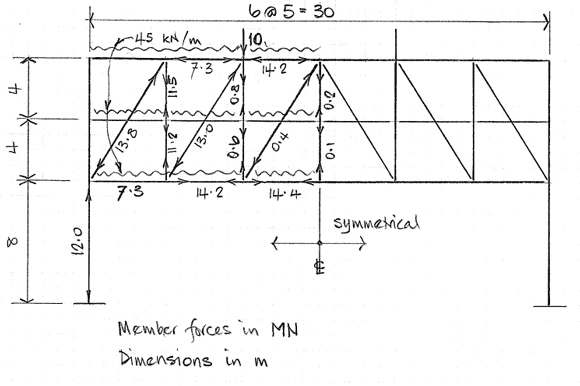
Figure 1: Truss arrangement diagonals in compression
It can be seen from Figure 1 that the length of the bottom chord carrying a force above 14 MN is more than 20 m long and will need a tension splice for transportation. Adopting a conventional N-frame is therefore considered to be preferable as the necessary splices can be located in elements with lower forces.
A truss with a single storey depth could be shop-fabricated and transported to site in three pieces with two bolted site splices. Erection time would be reduced but crane lifting capacity and transportation would need to be considered if this option is contemplated. The truss arrangement chosen, member forces and some member sizes are shown in Figure 2.
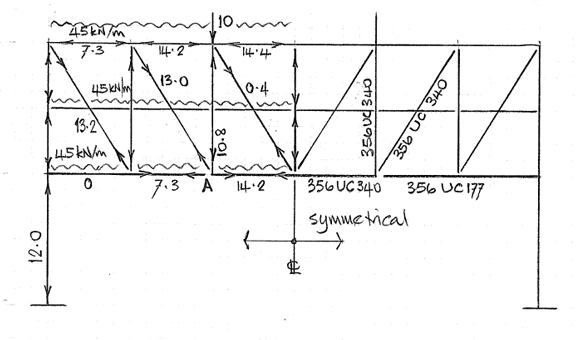
Figure 2: Truss arrangement diagonals in tension
Example connection design – orientation of members
Consider the joint at point A at the base of the column carrying 10 MN. The bottom chord member could be detailed as one fabricated assembly with a joint at each end to connect to the column, diagonal brace and the continuing chord member. At this joint, there is a tension in the central section of bottom chord of about 14.2 MN and a tension diagonal carrying about 13 MN. The chord member carries about 40% of the tension in each flange and 20% in the web. A conventional orientation of the members might be considered with the webs vertical as in Figure 3.
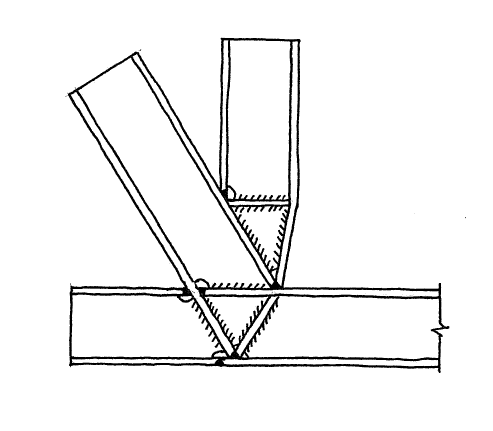
Figure 3: Bottom chord joint – webs vertical
A path for transferring the flange forces from the chord to the bracing member is necessary (because the forces are obviously too large to transfer through the webs) and an additional load bearing stiffener is necessary to carry the resultant force at the change in direction. As the forces are in tension, full strength welds would be required. The butt welds between the flanges are substantial and require cope holes through the web to achieve them. The webs would need to be checked for shear as well as axial load in the joint zone. This arrangement is not favoured.
Rotating the members so their flanges are vertical (Figure 4) provides a more direct path for the flange tension forces.
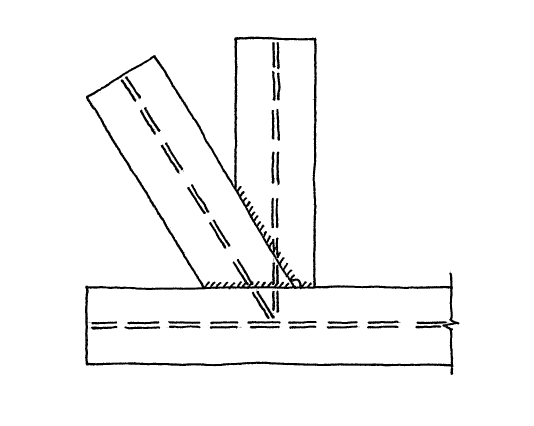
Figure 4: Bottom chord joint – flanges vertical
The connections between the members in the node can be made by butt welds between the edges of the flanges. The flow of force through the joint is smoother but the web force still needs to be transferred, and the junction where the webs of the three members come together is complicated.
A refinement of this arrangement, using two plates to form the node, separated by intermittent webs is the favoured solution (Figure 5).The plates toward the centre of the joint are wide enough to carry half the chord force so a web is only required close to the connecting member to transfer the web force into the plates. The plates are butt welded to the chord flanges and the tension diagonal is connected using a bolted splice. The column member is connected using a bearing splice.
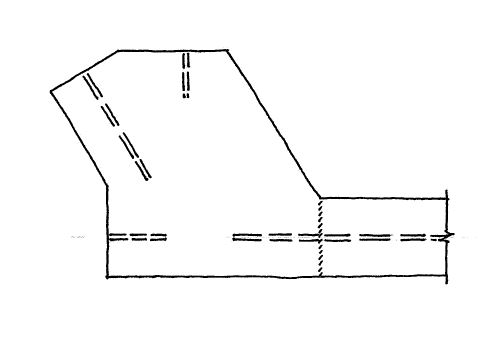
Figure 5: Bottom chord joint – splice plates
Joint design
The tension splice in the bracing member will be effected using M30 preloaded bolts of category B in double shear, of grade 10.9. The slip resistance assumed for design is for a friction coefficient μ = 0.5 and is 357 kN.
The member is a 356 UC 340 with 42.9 mm thick flanges and 26.6 mm thick web and has an area of 433 cm². The area of one flange is 40% of the total and carries 5.2 MN in tension. The number of bolts required is indicated in Table 2:

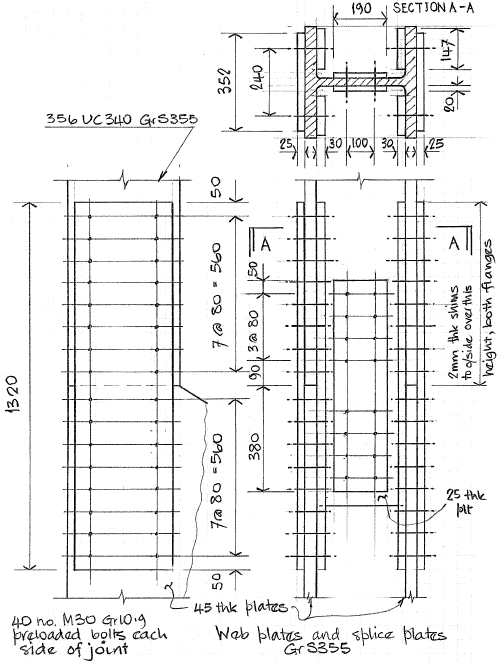
Figure 6: Bolted splice arrangement
The flange splice plates are chosen to provide the same area of metal as the flange with half the area on each side to balance the force on each shear plane in a bolt. The splice arrangement is shown in Figure 6. All bolts in the truss will be M30 grade 10.9 preloaded assemblies, category B.
The inside face of the plates in the node are arranged to line through with the inside face of the element flanges. Externally, shims are provided to reduce the difference in thickness to less than 1 mm.
The bearing splice in the column member must be designed for 25% of the maximum compression ie 2.7 MN. Dividing by the double shear resistance gives 7.6 bolts and four bolts will be used in each flange.
The tension connection for the continuation of the bottom chord will be detailed in a similar way to the tension diagonal with ten bolts in the flanges and six bolts in the web. The difference in flange thickness in this part of the joint is 21 mm and is achieved with two shims of 15 mm and 6 mm thickness.
The connection between the bottom chord and the node plates is required to transfer 14.2 MN in tension. The node plates will be butt welded to the bottom chord member. The force in the web will be transferred by welds to the node plates; either fillet welds or partial penetration butt welds can be used. This can be achieved either by stripping both flanges off the member to allow the web to project between the node plates or by butt welding an extension plate to the web. Short web plates are required between the node plates at each bolted connection to receive the web force and transfer it into the node plates through fillet welds.
The node plate geometry is such that the stress in the plates reduces rapidly away from the interface with the connected members. The resistance to compression from the vertical column must also be considered. A buckling check of the compression force in the node plates should be carried out. The final joint arrangement is shown in Figure 7.
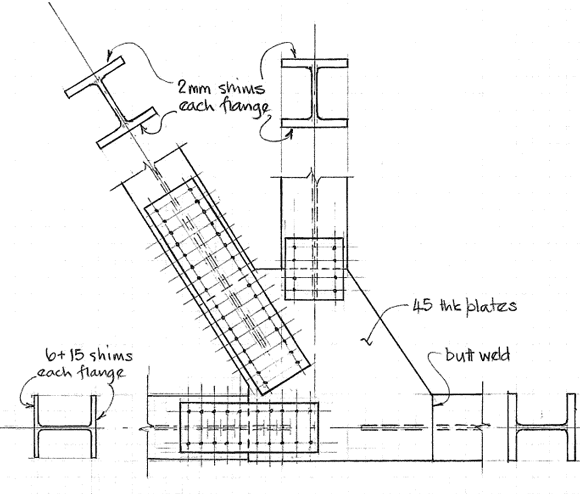
Figure 7: Bottom chord joint elevation
Conclusions
- Early consideration of the form of members in the truss (rolled or fabricated) may influence the depth adopted. Transportation, craneage, erection and the proportion of shop fabrication also influence the truss arrangement.
- The flow of forces through the joint is clear if the forces are in equilibrium. The orientation of members (webs vertical or horizontal) affects the need for and nature of welds required to transfer the forces.
- Facilitating the flow of forces between the element flanges results in a joint arrangement where member stubs are not welded together but plates are provided, aligned with the member flanges to carry the forces through the joint which reduces the stiffening required and the amount of welding.
- Fewer bolts would result if non preloaded grade 10.9 bolts were adopted (30 on each side of the diagonal member splice instead of 40) but the deflection of the truss would be more difficult to control because of bolt movement in clearance holes and bearing deformation.
- The double shear resistance of non preloaded M30 grade 10.9 bolts is only 4% greater than grade 8.8 bolts of the same size but this can be enough to produce a smaller number of bolts. Once selected, the bolt grade and size is fixed for the whole truss.
Reference
1 Steel construction with trusses, NSC, March 2017









